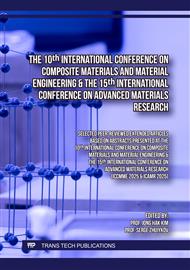[1]
Lionetto F, Moscatello A, Totaro G, Raffone M, Maffezzoli A. Experimental and Numerical Study of Vacuum Resin Infusion of Stiffened Carbon Fiber Reinforced Panels. Materials 2020;13:4800.
DOI: 10.3390/ma13214800
Google Scholar
[2]
Sozer EM, Simacek P, Advani SG. Resin transfer molding (RTM) in polymer matrix composites. Manuf. Tech. Polym. Matrix Compos. PMCs, Elsevier; 2012, p.245–309.
DOI: 10.1533/9780857096258.3.243
Google Scholar
[3]
Okabe T, Oya Y, Yamamoto G, Sato J, Matsumiya T, Matsuzaki R, et al. Multi-objective optimization for resin transfer molding process. Compos Part Appl Sci Manuf 2017;92:1–9.
DOI: 10.1016/j.compositesa.2016.09.023
Google Scholar
[4]
Han SH, Cho EJ, Lee HC, Jeong K, Kim SS. Study on high-speed RTM to reduce the impregnation time of carbon/epoxy composites. Compos Struct 2015;119:50–8.
DOI: 10.1016/j.compstruct.2014.08.023
Google Scholar
[5]
Van Oosterom S, Allen T, Battley M, Bickerton S. An objective comparison of common vacuum assisted resin infusion processes. Compos Part Appl Sci Manuf 2019;125:105528.
DOI: 10.1016/j.compositesa.2019.105528
Google Scholar
[6]
Ouezgan A, Mallil EH, Echaabi J. Manufacturing routes of vacuum assisted resin infusion: Numerical investigation. J Compos Mater 2022;56:3221–36.
DOI: 10.1177/00219983221111492
Google Scholar
[7]
Lopatnikov S, Simacek P, GillespieJr J, Advani SG. A closed form solution to describe infusion of resin under vacuum in deformable fibrous porous media. Model Simul Mater Sci Eng 2004;12:S191–204.
DOI: 10.1088/0965-0393/12/3/S09
Google Scholar
[8]
Correia NC, Robitaille F, Long AC, Rudd CD, Šimáček P, Advani SG. Analysis of the vacuum infusion moulding process: I. Analytical formulation. Compos Part Appl Sci Manuf 2005;36:1645–56.
DOI: 10.1016/j.compositesa.2005.03.019
Google Scholar
[9]
Arulappan C, Duraisamy A, Adhikari D, Gururaja S. Investigations on pressure and thickness profiles in carbon fiber-reinforced polymers during vacuum assisted resin transfer molding. J Reinf Plast Compos 2015;34:3–18.
DOI: 10.1177/0731684414560220
Google Scholar
[10]
Ouezgan A, Adima S, Maziri A, Mallil EH, Echaabi J. Relaxation Compression Resin Transfer Molding Under Magnetic Field: Modelling and Numerical Investigation. Appl Compos Mater 2023;30:677–704.
DOI: 10.1007/s10443-023-10108-w
Google Scholar
[11]
Song YS, Youn JR. Numerical investigation on flow through porous media in the post‐infusion process. Polym Compos 2009;30:1125–31.
DOI: 10.1002/pc.20668
Google Scholar
[12]
Chung Hae Park, Saouab A. Analytical Modeling of Composite Molding by Resin Infusion with Flexible Tooling: VARI and RFI processes. J Compos Mater 2009;43:1877–900.
DOI: 10.1177/0021998309341848
Google Scholar
[13]
Bickerton S, Buntain MJ. Modeling forces generated within rigid liquid composite molding tools. Part B: Numerical analysis. Compos Part Appl Sci Manuf 2007;38:1742–54.
DOI: 10.1016/j.compositesa.2006.11.001
Google Scholar



